Squealing kids playing in the tiny lanes
Lined with vibrant homes with beautiful window panes.
Tinkle of the stream and the chime of the prayer wheels add to the twitter song
All these bring alive the 9th century Dirang Dzong.
Discover the living fortress in Dirang Village. Explore the best things to do and see inside Dirang Dzong and get my insider tips on how to make the best of your visit here.
When I heard the name “Dirang Dzong”, I was immediately transported to Bhutan. I visualized the exotic wooden administrative buildings and ornate monasteries against the backdrop of the mountains. Dirang Dzong in Arunachal Pradesh may not be as majestic as the Bhutanese ones, but it was equally intriguing to me.

For one, there were conceptual similarities between the two – naturally so, given the proximity of Dirang in Arunachal Pradesh to Tibet and Bhutan. Two, this Dirang attraction was possibly the oldest and still thriving Dirang village, featuring classic Monpa homes and a wealth of folklore and stories. I highly recommend a walk through this gem – one of the best Dirang tourist places.
In this blog post, I will take you on a virtual tour of this Dirang Village. I will share all the key attractions to see inside Dirang fort as well as give you tips on how to get to Dirang valley, where to stay and eat.
I am sure you will love the Dirang Dzong story and will soon add this to your Arunachal Pradesh trip. So let’s get started.
Quick links for your visit to Arunachal Pradesh and Dirang Dzong
- Consider Holiday Scout for your bookings and trip to Arunachal Pradesh. Check this post to know why I recommend them. They will help you with an end-to-end booking from cars to stays and guides.
- Booking.com has a few Arunachal Pradesh hotels and stays that you can consider if you are booking on your own.
- For any of your travel needs or general shopping, consider using Amazon through this link.
Disclaimer: This article includes affiliate links. This means that at no cost to you, I will receive a small commission if you purchase through my link. Thank you for supporting me with this.
Contents
- 1 What is a Dzong?
- 2 History of Dirang Dzong
- 3 Architecture and layout of Dirang Dzong
- 4 What to see inside Dirang Fort? (Key attractions and folklores)
- 4.1 The Dirang Dzong entrance and gate
- 4.2 Dirang village town hall
- 4.3 Military barracks and prison inside Dirang Dzong
- 4.4 Choime Lhakhang – the original Dirang Dzong Monastery of Dirang valley
- 4.5 The original Dirang Basti and Monpa homes
- 4.6 Village by the river in the Dirang Dzong
- 4.7 Prayer wheels & monastery by the river
- 5 Common FAQs about Dirang Dzong – one of the tourist places in Dirang town
- 5.1 What is the best time to visit Dirang Dzong?
- 5.2 What is the best way to get to Dirang Dzong?
- 5.3 Which is the best place to stay in Dirang?
- 5.4 Is there any entrance fee to visit Dirang Dzong?
- 5.5 Are there any guided tours of Dirang Dzong?
- 5.6 Is Dirang Dzong worth visiting?
- 5.7 How many hours do you need in Dirang Dzong?
What is a Dzong?
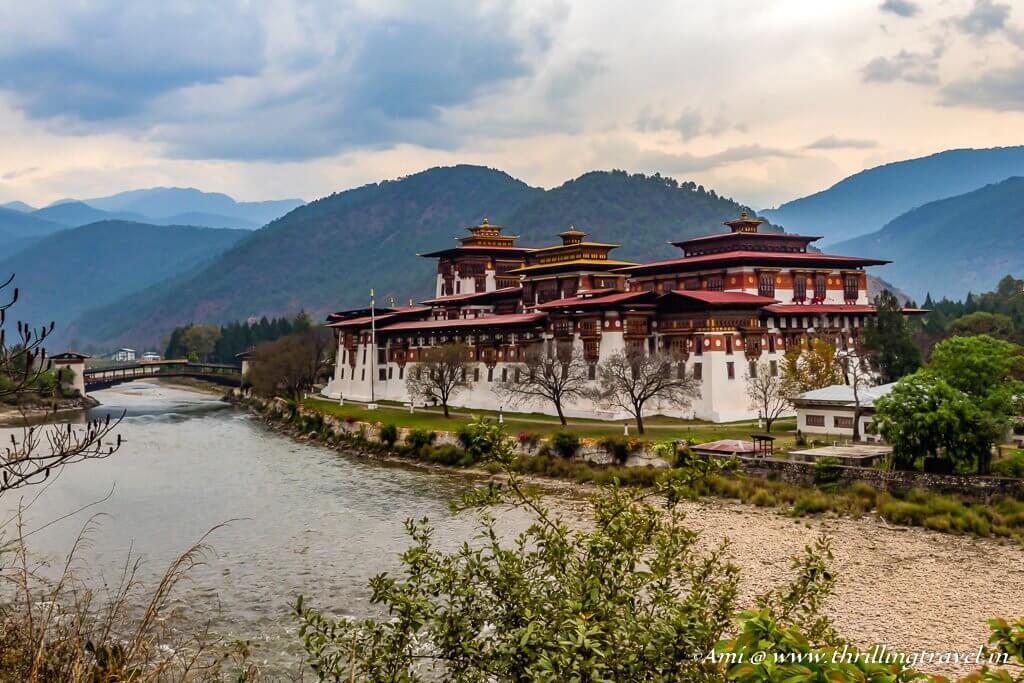
Alright, so I have been constantly mentioning the term -Dzong. Many of you who have traveled to Bhutan or Tibet might be familiar with the concept of a Dzong. In simple parlance, it is nothing but a fortress that includes centers for religious, military as well as administrative or political affairs. In Bhutan and Tibet, there are various districts or regions that are governed by a Dzong in that region.
Within the protective walls of the Dzong are impressive buildings separated by elaborate courtyards – all of which are used for important festival as well as military events. In most cases like the Punakha Dzong and Thimphu Dzong, the buildings too, are architecturally pleasing with their intricate woodwork and designs.

Discover the lovely Thimphu Dzong and what lies inside. Check this blog and you will know why it is so different from the Dirang Dzong
Dzongs have been in existence since the 16th-17th century across Tibet and Bhutan – essentially the Buddhist belt. Arunachal Pradesh too, fell in this zone at that time and hence, it has its share of Dzongs – of which Dirang Dzong still exists and thrives. It is unique – quite unlike the Bhutanese Dzong which is why I peg it down as one of the key places to visit in Dirang.
History of Dirang Dzong
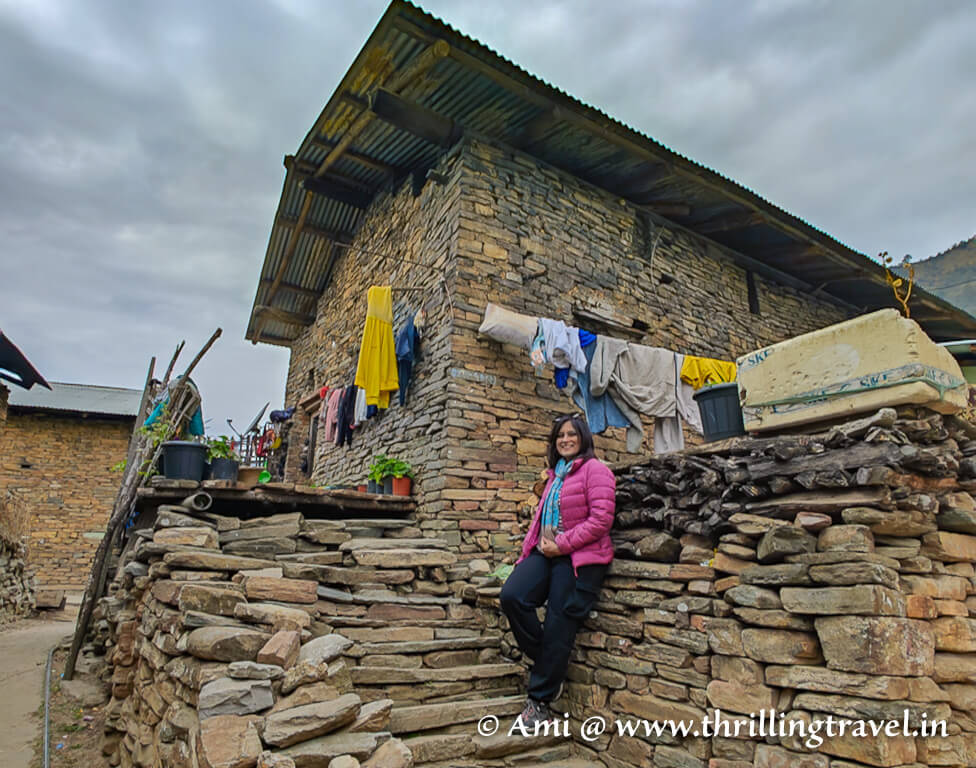
Even before the protective enclosure of the fortress, there existed a Monpa settlement in Dirang Valley. The tiny hamlet that can be traced back to the 9th century was a part of the route connecting Tibet to the rest of India and Bhutan. The village thrived on farming in the rich Dirang valley as well as on the trade resulting from the cross-over route to Tibet on which it was located.
The 17th century ushered in an era of governance and taxation by the order of the 5th Dalai Lama. The powerful religious leader established four Dzongs in Arunachal Pradesh to monitor and collect revenue as well as protect the villages from the increasing attacks of the neighboring kingdoms. This is when Dirang Dzong first came into existence, encircling the Monpa village and its surrounding land.
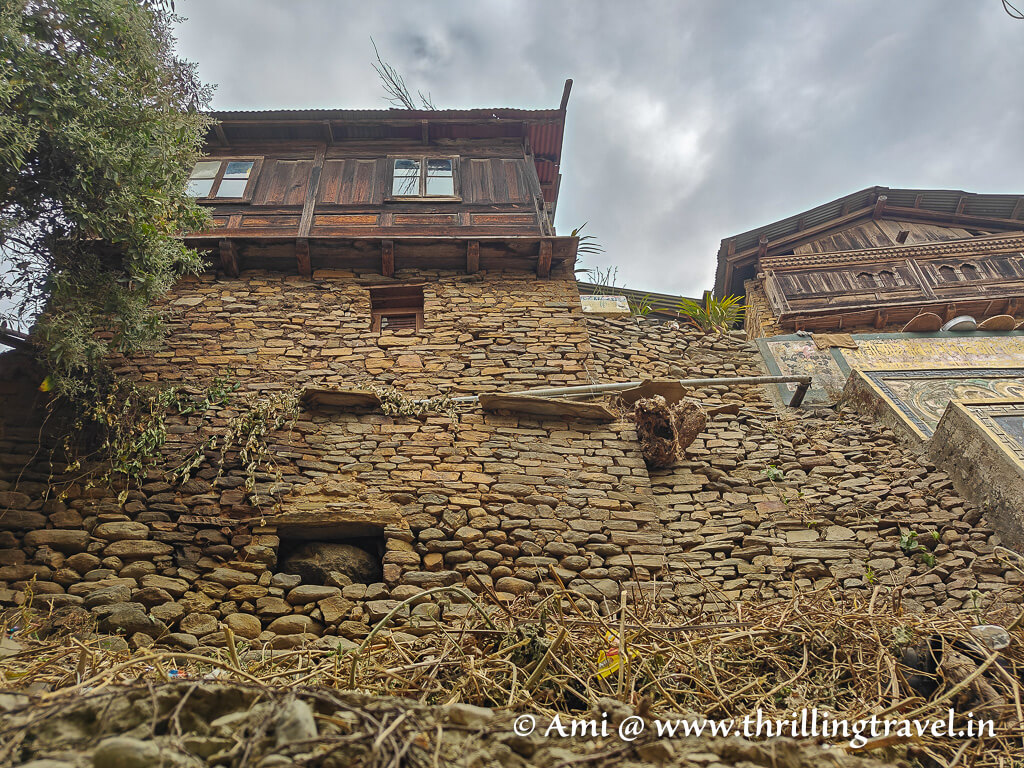
Though there is no clear documentation, most people believe that the name “Dirang village” was conferred to the 9th-century Monpa settlement after the Dirang Dzong was established. Today, however, the term also, includes the other small hamlets around the original village and extends beyond the walls of Dirang fort.
It is the presence of this village – which is still a living heritage that makes Dirang Dzong different from the other Bhutanese Dzongs that I had seen. However, it adheres to the concept of Dzongs with a small Dirang monastery within its walls as well as the presence of a former town hall and an administrative as well as military center.
Architecture and layout of Dirang Dzong
Dirang Dzong exhibits a lovely mix of Bhutanese decor and the traditional Monpa tribal architecture. There is only one way into the fortress – by way of its ancient gate that is attached to two ramparts. Inside the Dzong, there is a small section that has all the official buildings of the Dirang fort. The rest of the area includes the settlement of the old Dirang village.
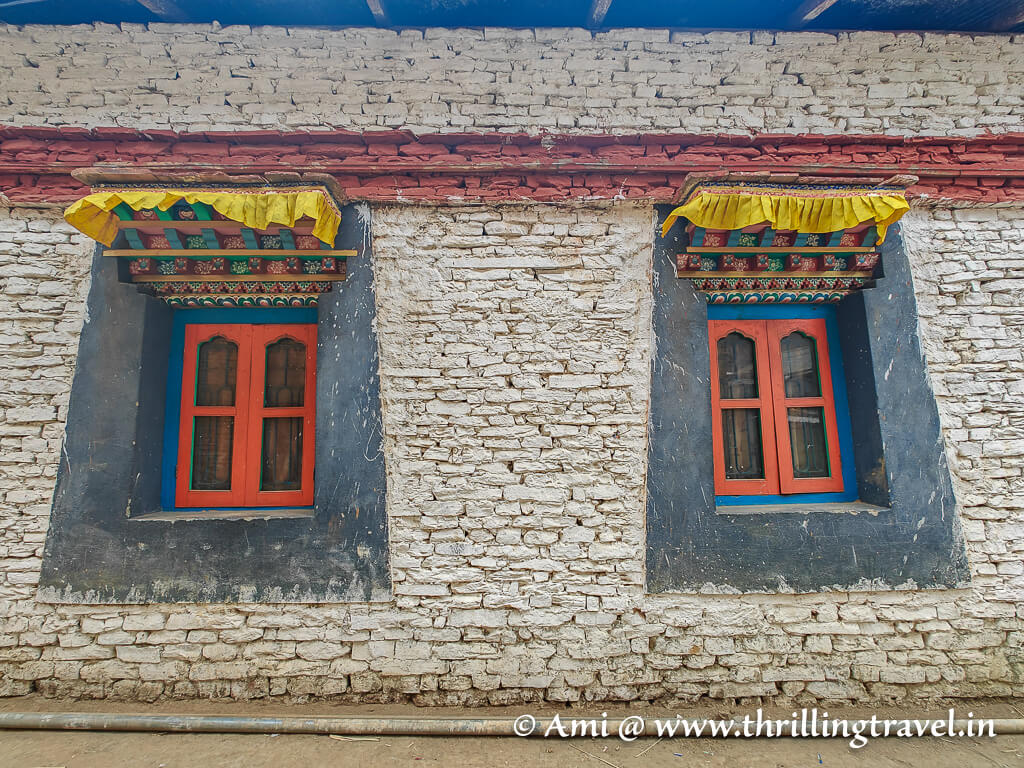
As I mentioned, initially there was only one village within the Dzong but as time passed, this extended to another village (Gomluk or Dokpuk, I missed the name). Each of the villages had its own monastery, though the original Dirang monastery inside the Dirang Dzong is the one closest to its gate.
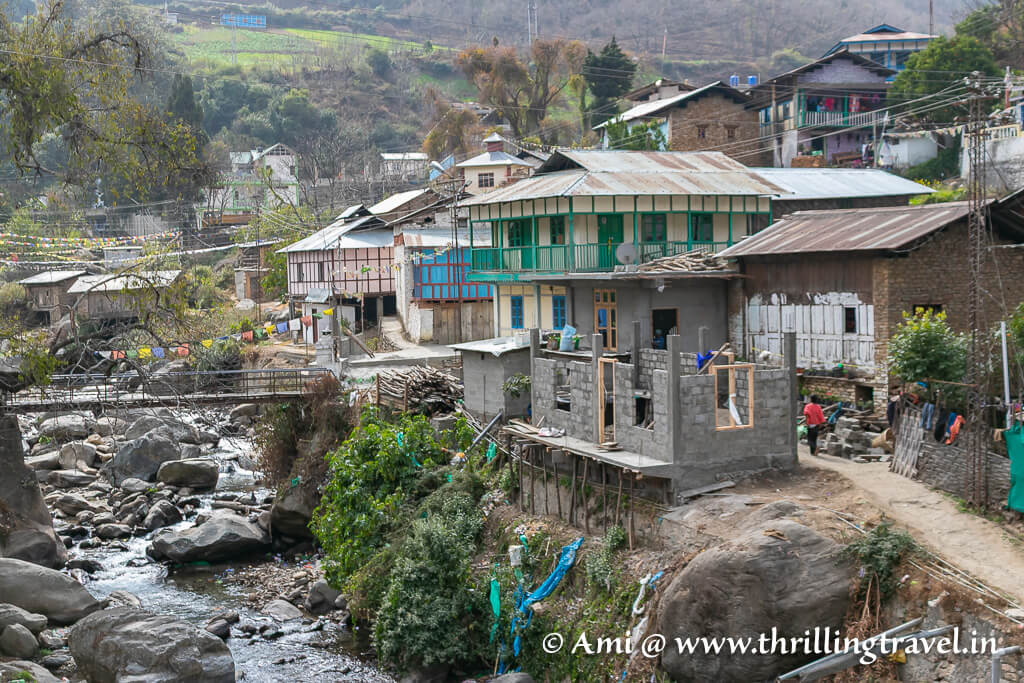
You will find a stream passing by the Dzong walls and some parts of the village, which adds a certain charm to the entire Dirang fort layout. And of course, prayer flags are swaying around across the village – adding their colorful vibes to the place.
What to see inside Dirang Fort? (Key attractions and folklores)
It is time for a walk through Dirang Dzong and enjoy the tiny tales that lurk in every corner. You will find these stories in the architecture, in the playful kids that you likely will encounter in those tiny lanes and the smiling Monpa people who are happy to showcase their humble abodes. I promise you that your visit to Dirang Dzong is a cultural fiesta.
The Dirang Dzong entrance and gate
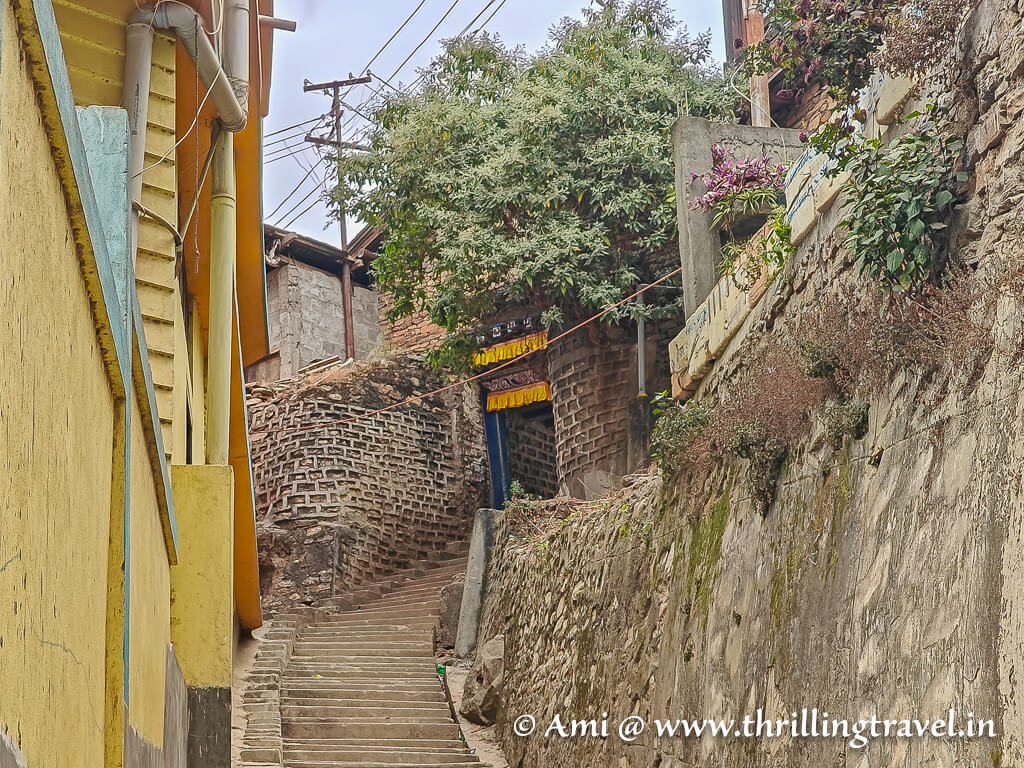
Just off the Tawang-Dirang highway, you have to follow a nondescript lane that takes you to a flight of stairs sandwiched between the modern settlements and the heritage stone and wooden abodes. For a moment, I thought we were in the wrong space till I saw the massive stone embankments at the end of the stairway.

However, it was not the gate that held my attention. It was in fact, the stone wall that intrigued me. The faded paintings on the layered wall – which seemed to be more of a recent phenomenon, enhanced the elegant wooden and clearly heritage house above it. The carved wooden eaves clearly indicated that it belonged to someone important – maybe the chieftain or the head monk – no one at this point knows.
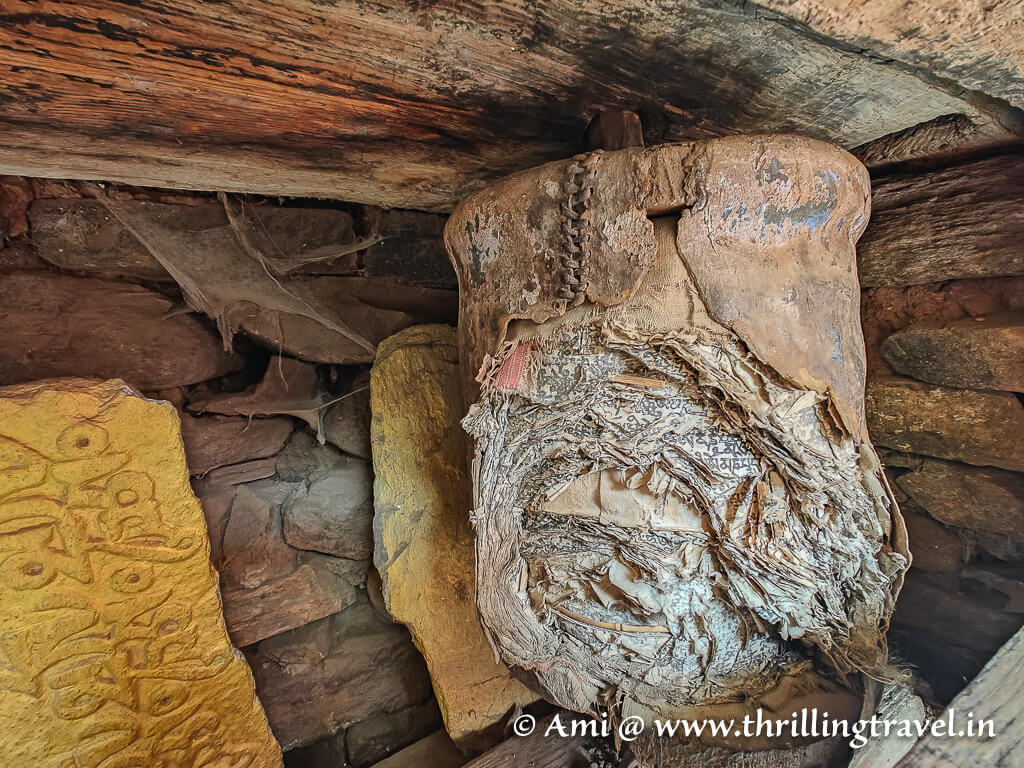
Once at the gate, don’t miss the crumbling prayer wheels flanking the entrance. It is here that I could clearly see what went into making these divine structures. You can clearly see the parchments that are enclosed in the wheels – a practice that still continues. As our guide Lamu said – “Even today, when we make prayer wheels in the monastery, the monks give sacred parchments that have to be enclosed inside them. These contain scriptures that help spread the good vibes when you rotate the wheels and chant “Om Mani Padma Hum”.
With that interesting tale and fact, I passed through the narrow entrance of the ancient Dirang Dzong – one of the key Dirang tourist places.
Dirang village town hall
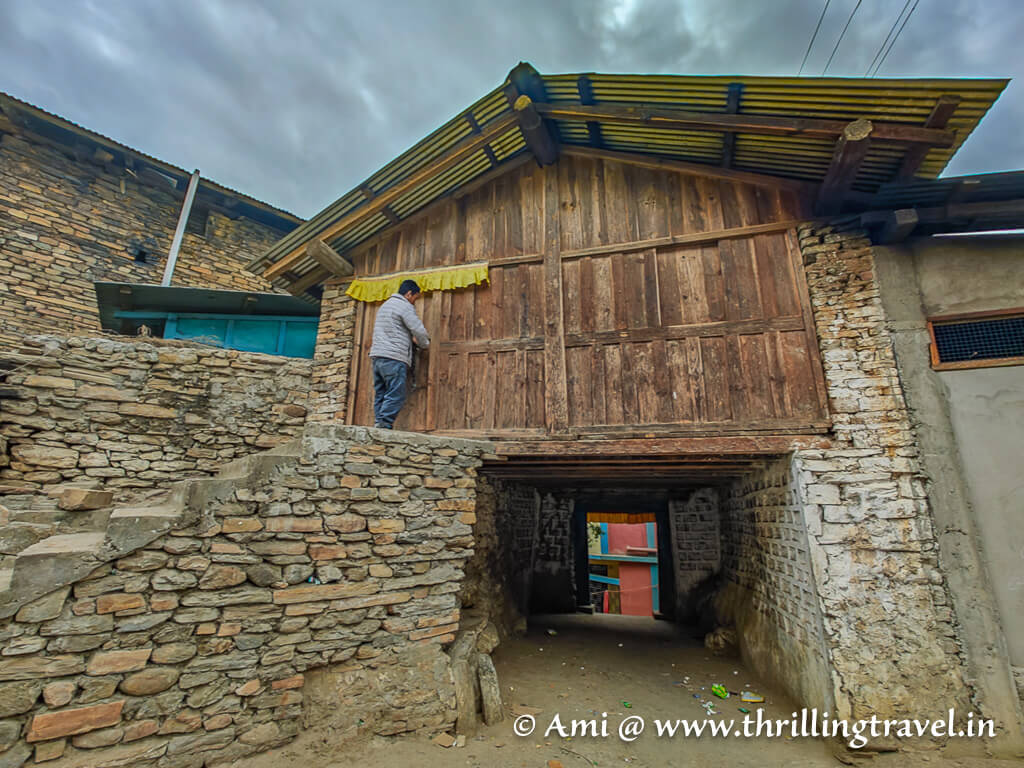
Right over the entrance is the Dirang Basti town hall that is still actively used by the village council. I think there was a meeting that has just concluded when I visited and they were just locking it down. The town hall at one point was used as a watch house for the Dzong and was heavily guarded. The space is a simple hall that could accommodate all the important people of the Dzong for a meeting.
Military barracks and prison inside Dirang Dzong
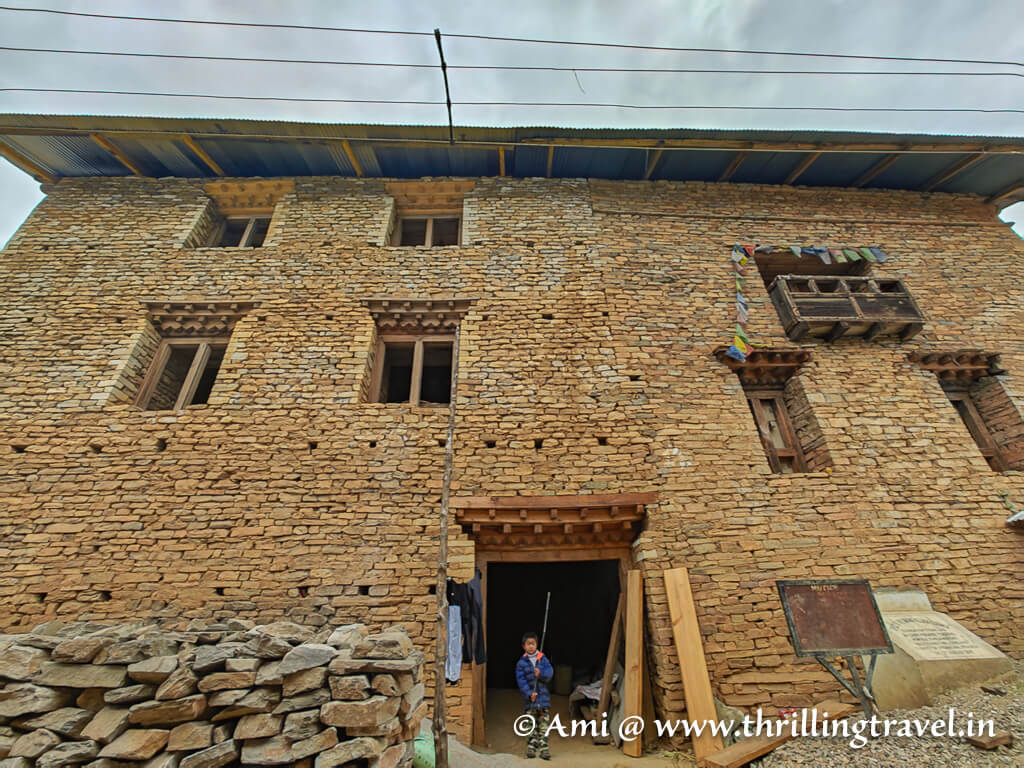
“There was a time when many people were imprisoned for petty crimes.One old lady – who used to have the the prison keys, used to secretly go in the night and free them” – narrated Lamu. It is believed the ghost of this lady still walks through the village. The residents claim that they can sometimes they can still hear the jingle-jangle of the keys in the night.
True or not, this Dirang ghost story shrouding the military barracks and prison made the innocuous structure interesting in my eyes. There was some restoration work happening in the complex which stopped me from exploring it from inside. The building is soon going to be used as a museum for Dirang Dzong – making sure that this fort is one of the key places for Dirang sightseeing.
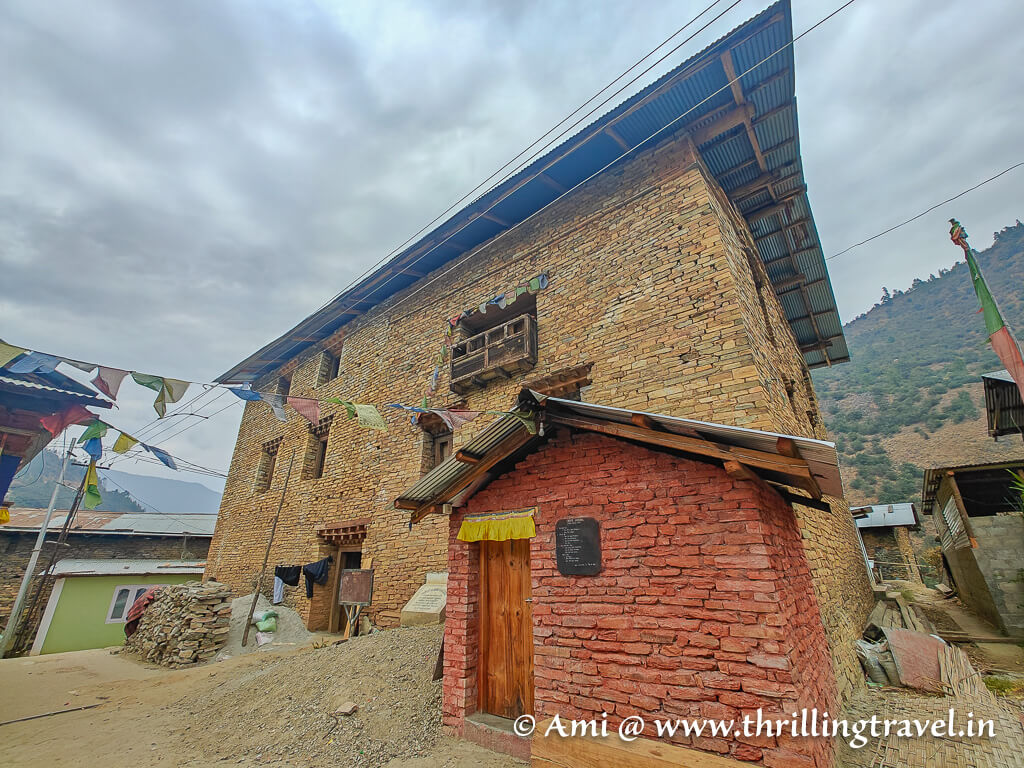
The ground floor of this building served as a prison while the first floor was for administrative offices. The top floor had living spaces for the various heads – jailors, head monks and even the village headman.
Choime Lhakhang – the original Dirang Dzong Monastery of Dirang valley
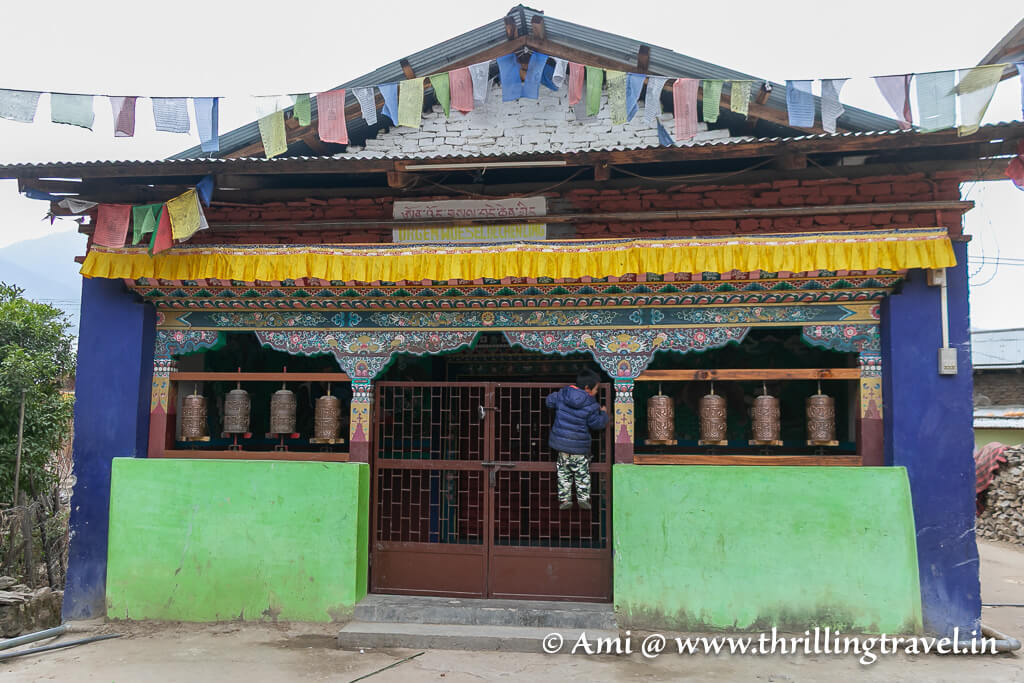
Right opposite the prison building is the small monastic prayer room. There is a small butter lamp house right next to the barracks. This is what was the original monastic part of the Dzong in Dirang.
Small but sufficient for the people living within the Dzong, this is still active and is maintained by the residents. You can clearly see the Bhutanese – Tibetan touch in the colorful eaves and windows of the monastery.
That concludes the administrative, monastic and military are of the Dirang fort – features that are typical of a Dzong. Now, what you will see in this Dirang Dzong walk is the part that distinguishes it from the Bhutanese Dzongs.
The original Dirang Basti and Monpa homes
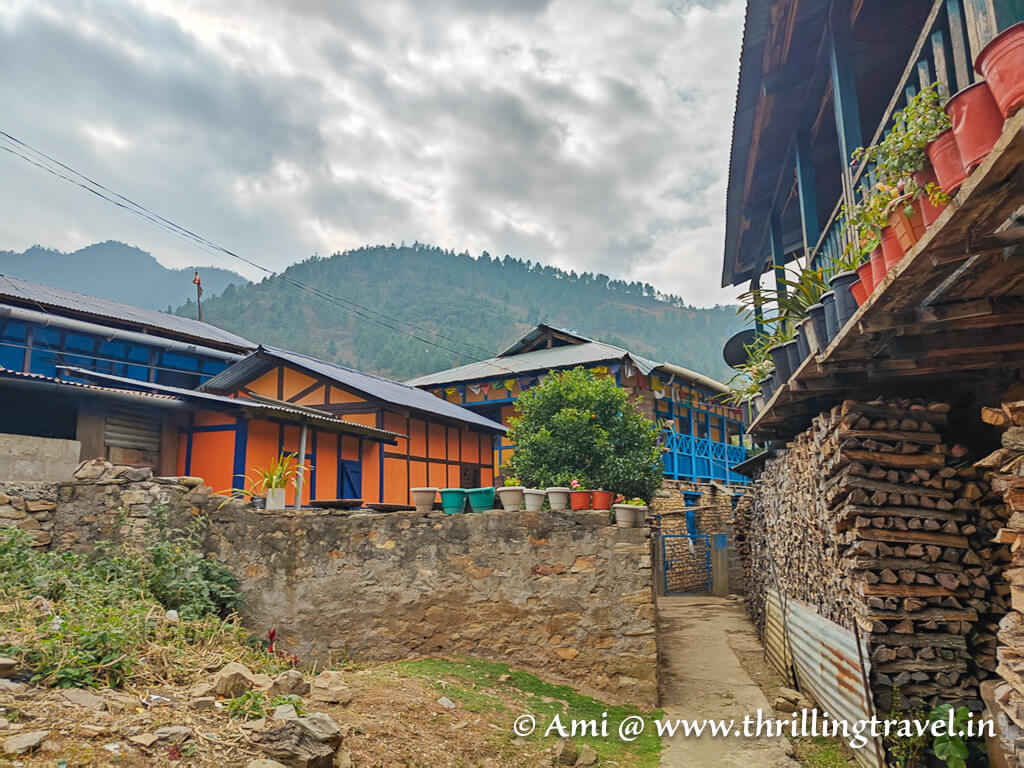
The lack of majestic buildings that I visualized from my visit to Bhutan was more than offset by the charming, multi-colored houses in Dirang Basti. The stone and wooden mansions had a rustic aura that belied the practical and smart climate-sensitive architecture. Wood in particular was quite creatively used within and outside these Monpa homes.
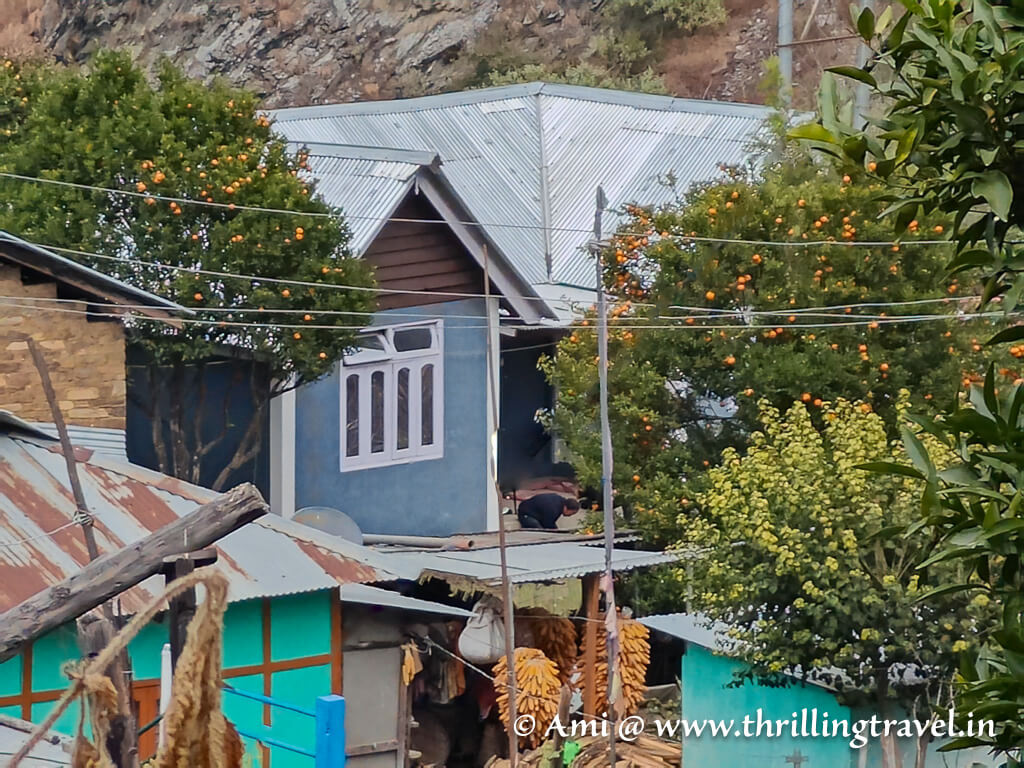
With the wooden floors and Bamboo-wooden roofs, the homes remained warm in the winters while the stone reinforcement ensured strength and stability. Adding to their cheerful facade, were strings of corn in the porticos – something that I have seen only in the corn village of Uttarakhand. This stems from a traditional practice where the corn would add to the decor like a toran and bring good luck. It also, served to dry the corn that is extensively used in their traditional menu.
Almost every home had a stack of wood outside – which I personally thought added another aesthetic element to the home front. The wood slabs are actively used to light the Bukhari within the Monpa houses – a structure that again has a dual function. Another thing to notice outside some of these homes is a stone well or storage.
Notice the front doors of the Monpa homes. The low door frame has an interesting explanation to it. They say that the spirits of the dead follow back the residents after the funeral and to ensure they do not enter the house, the door was made such that one has to bend and get it. That prevented the spirits from returning. – Interesting folklore, isn’t it?
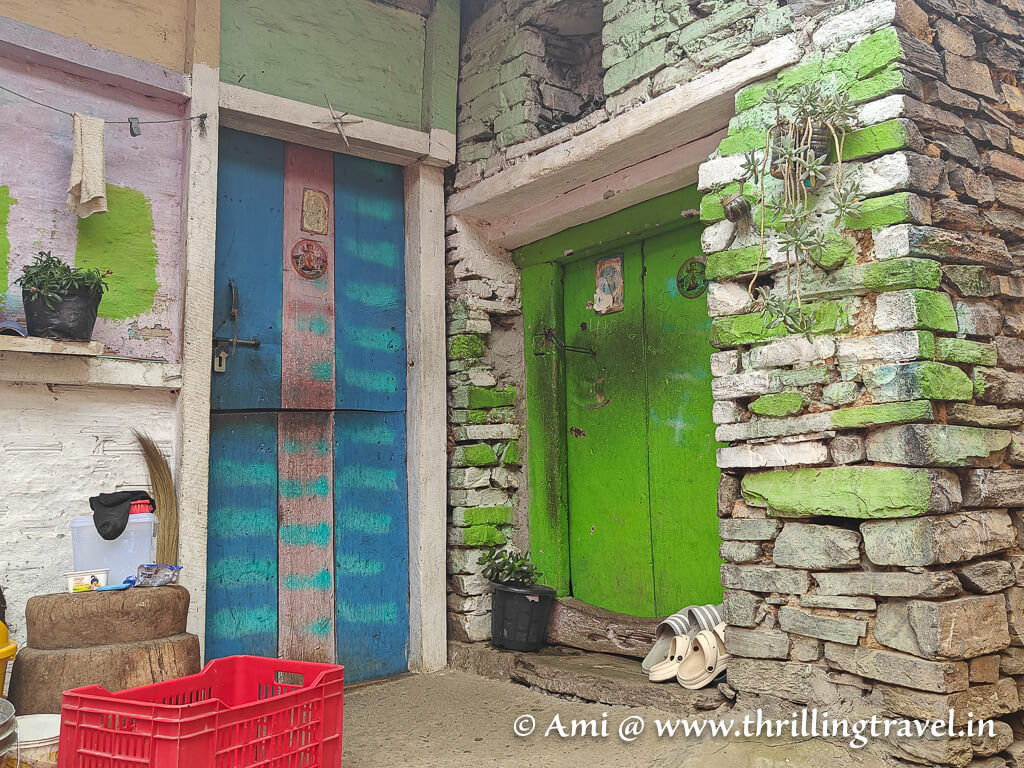
If you are lucky enough to be invited into a Monpa home, grab it! The layout of a Monpa home is simple but you will admire the ingenuity of it. Most of these homes have one floor. The ground floor usually has the living room and kitchen. The kitchen in fact, doubles up as a living room with a Bukhari – traditional fireplace with a cylindrical structure where the wood is burnt. At one end of the cylinder is a chimney that leads the smoke out of the house while the other has an opening. The space around it is used to heat water.
In the Monpa homes that I visited, the kitchen is not just about cooking but is a place to meet and spend time with family. Very few of these homes had a separate bedroom – makeshift beds were created around the Bukhari as the family huddled together in the cold.
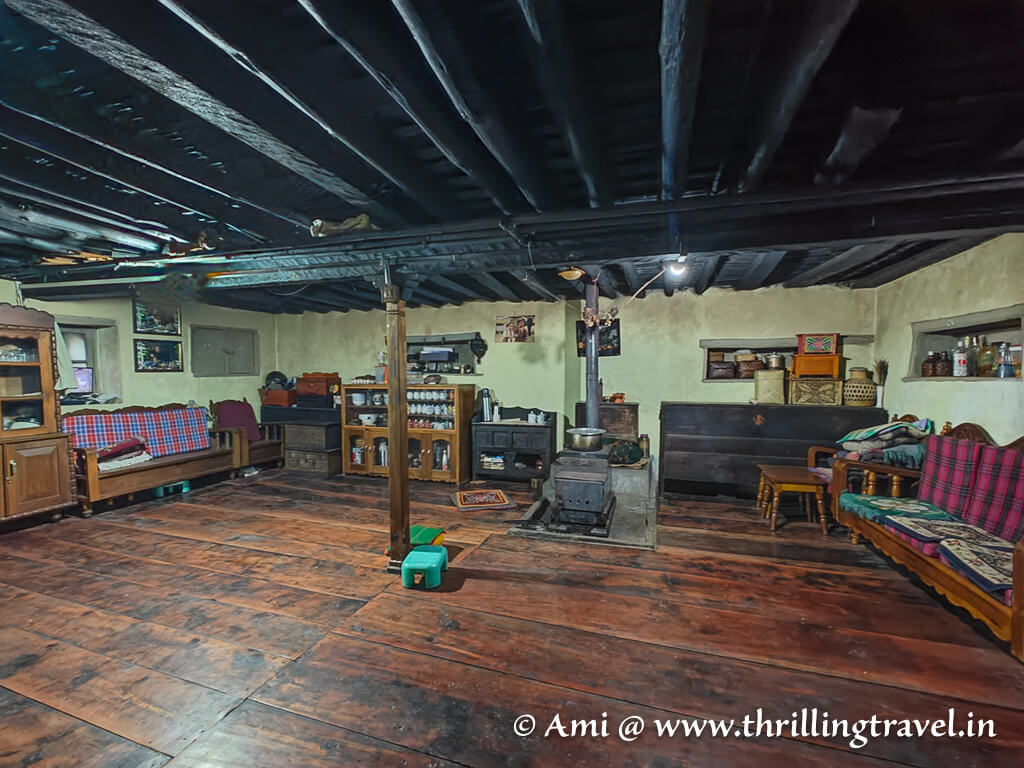
The upper floor can be accessed only with a traditional ladder. This space is exclusively a storage area – mostly used a a granary. In one of the homes, there was a prayer room included in this area.
Pots and planters are used around the ledges in almost every home – all stemming from the Monpa culture that believes in coexisting with nature.
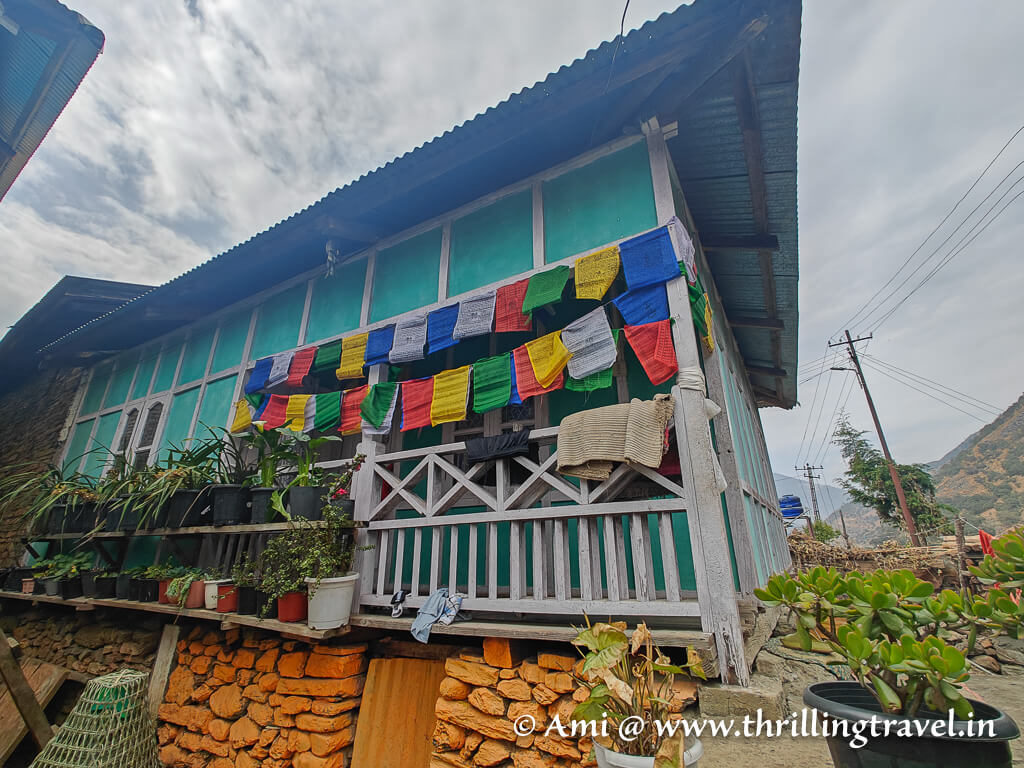
I just could not get enough of these houses. They further enticed me with the truants who followed the curious travelers around and the absolutely adorable furries barking at the gates. At the far end of the village, you get a gorgeous view of the Dirang valley and river.
Among these homes, there are a few Dirang homesteads that you can consider if you are planning on staying in Dirang. These are available on sites like booking.com or you can call Holiday Scout for booking them.
Village by the river in the Dirang Dzong
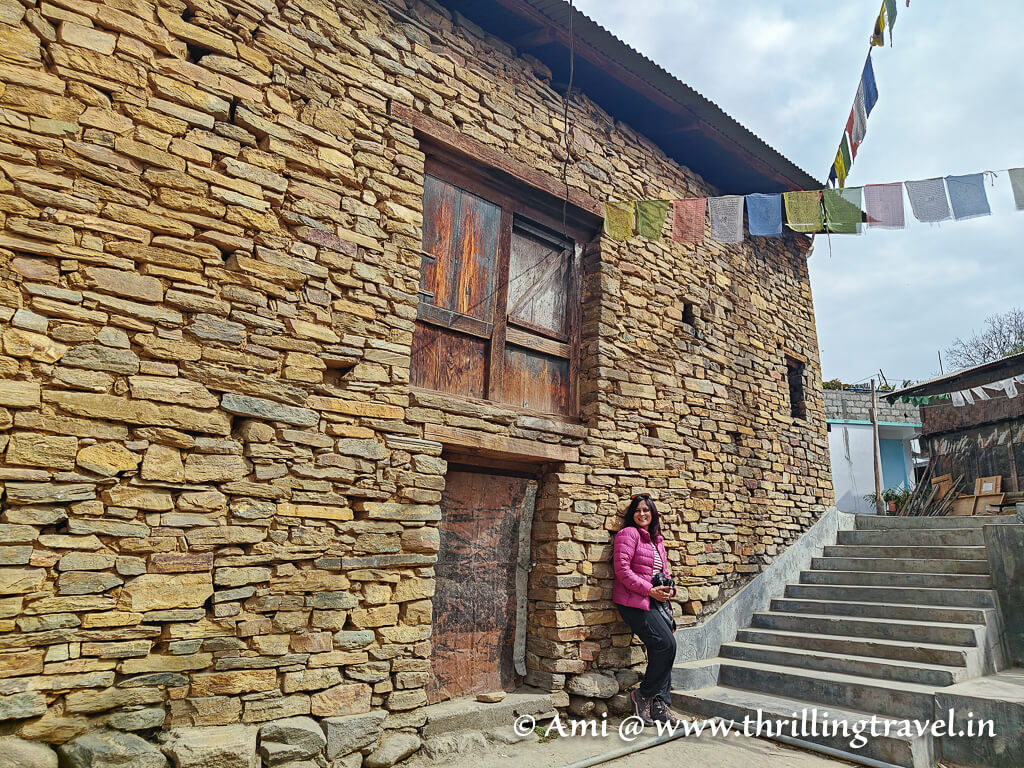
Remember I mentioned that the Dirang village expanded within the Dzong. Well, you can walk down a small path and get to it. This village is by the stream and has bigger Monpa homes. You will find the lanes also, slightly bigger.
Personally, though, I loved the first village of the Dzong for its more traditional set-up. That said, there was one part of the newer village – which is as below.
Prayer wheels & monastery by the river
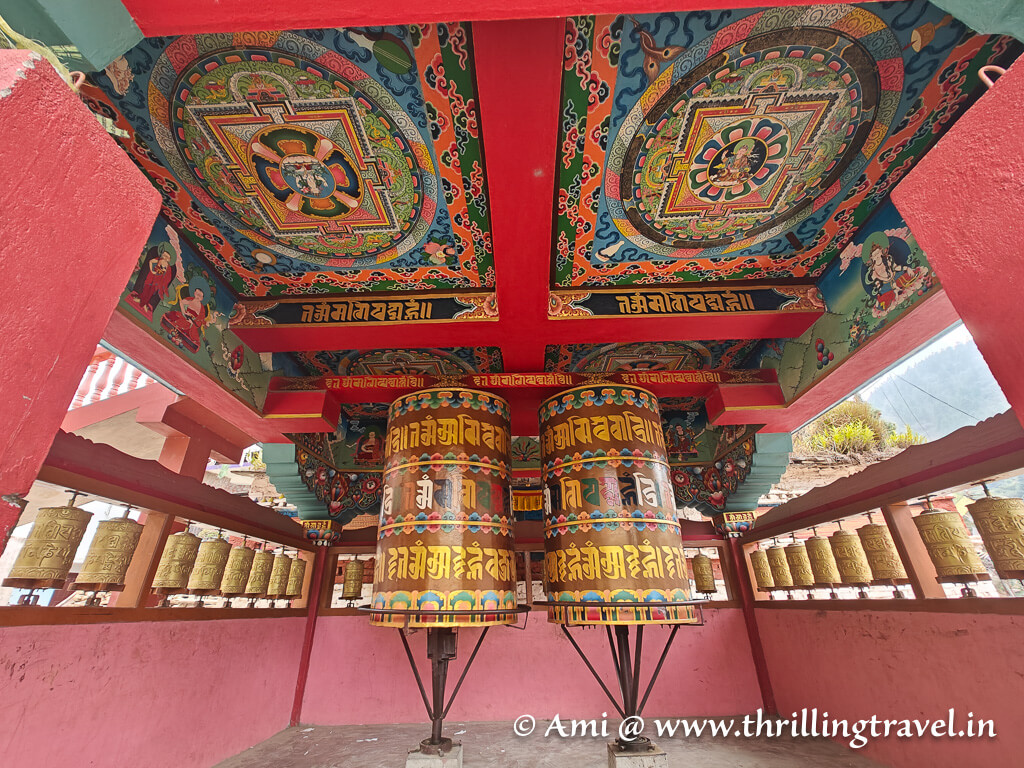
Where there was an animated beauty in the older Dirang Dzong basti, the newer hamlet exuded a serene landscape with its vibrant monastery and prayer wheels. Located right by the stream, the setting was picturesque. It was a healing combination of the melodious chimes of the prayer wheels and the soothing flow of water that made me enjoy this setting. A befitting and tranquil way to end the heritage walk through Dirang Dzong – one of the best places to visit in Dirang, Arunachal Pradesh.

Common FAQs about Dirang Dzong – one of the tourist places in Dirang town
What is the best time to visit Dirang Dzong?
The best season to visit Dirang would be between Mid-February to May and between October to November. Monsoons bring in really heavy rains and you might find them intervening with your outdoor plans.
Dirang Dzong does not have any opening or closing hours as it is a living locality. However, to explore, it is best to get there when there is sunshine so that you can enjoy the colors and local life better.
What is the best way to get to Dirang Dzong?
Dirang Dzong is located just 6 km from Dirang market on the Tawang – Dirang- Bomdila highway. You can hire a local taxi to get here or just drive down the highway. You can park your car near some of the stores on the main road.
Which is the best place to stay in Dirang?
I highly recommend Dirang boutique cottage which is on the other side of the river, near the Dirang Dzong. Not only is it comfortable, but the setting by the river makes is just perfect to relax and take in the Dirang vibes. You can book the same through Holiday Scout.
There are several other Dirang homestay options within the Dirang Dzong that you can book either through Holiday Scout or booking.com. Dirang also, has a few mid-priced and budget hotels but they would be closer to the new town and market area.
Is there any entrance fee to visit Dirang Dzong?
No, currently there is no entrance fee to enter Dirang Dzong. It is free for everyone. Just be aware though that it is a living locality and you must respect the local sentiment and privacy.
Are there any guided tours of Dirang Dzong?
You can request Holiday Scout for a guided tour of Dirang Dzong. Just check this link to know why I recommend them.
Is Dirang Dzong worth visiting?
Absolutely! It is the best place to experience the local culture and get interesting stories – some legends and some historical facts about Dirang, Arunachal Pradesh and the Dzong itself.
How many hours do you need in Dirang Dzong?
45 minutes to 1 hour would be good for Dirang Dzong. I however, spend more than that here as the cultural and heritage relevance of the place intrigued me.
Before you go, pin this
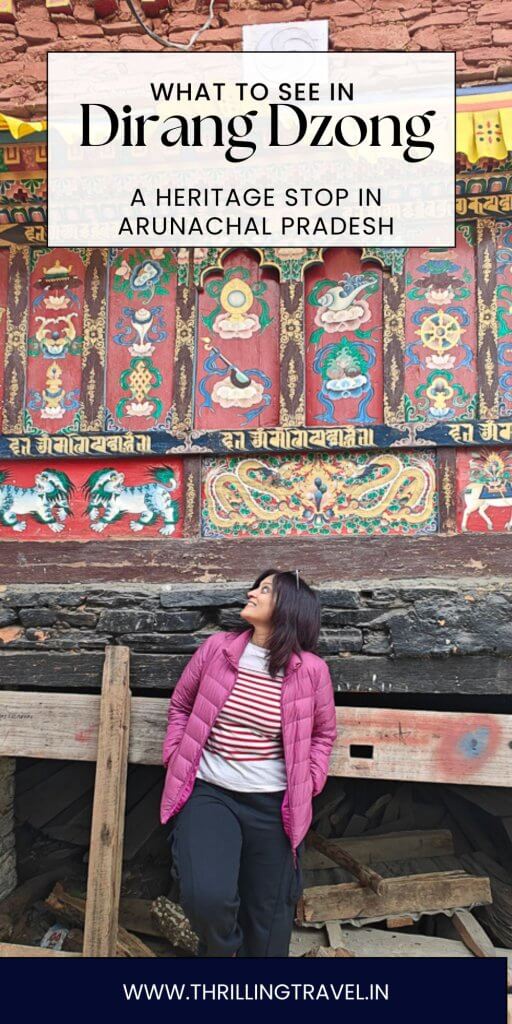
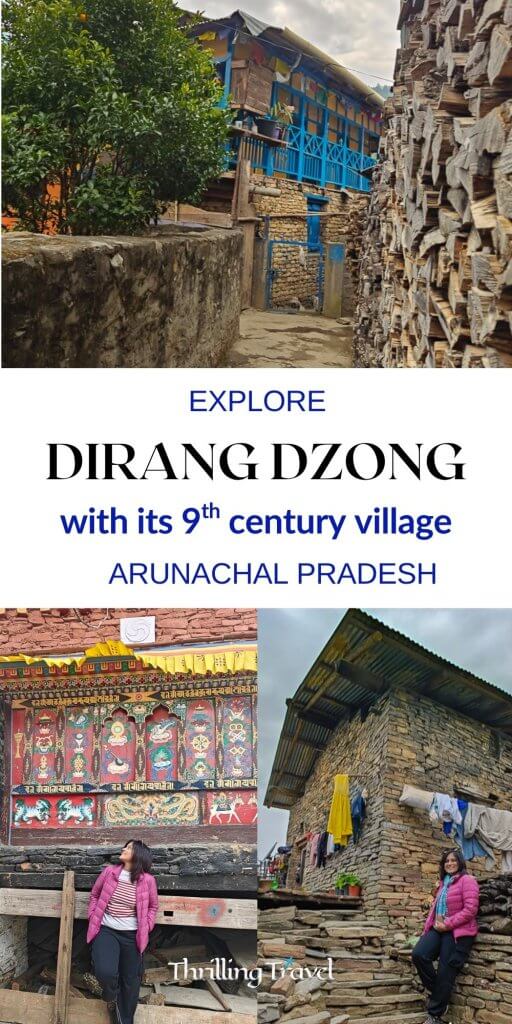
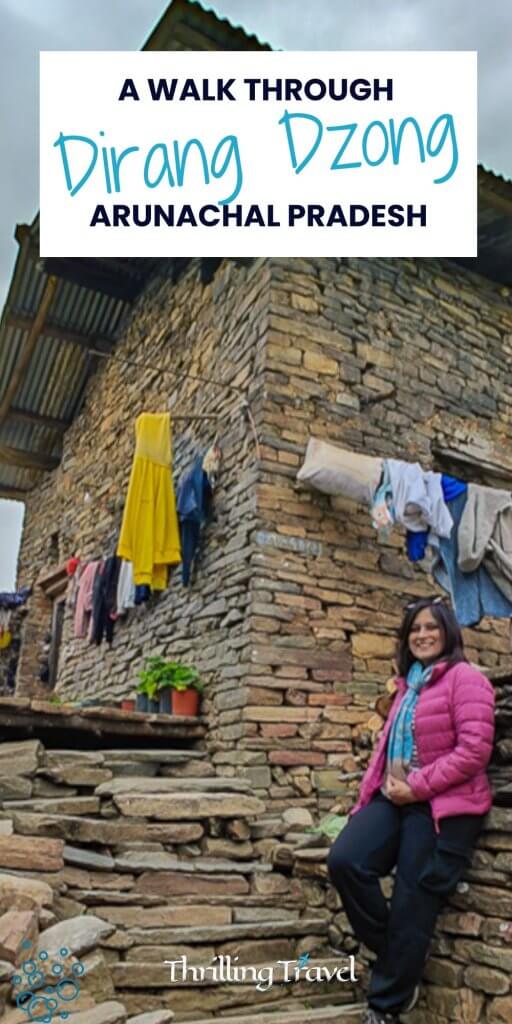
Popularly referred to as a Restless Ball of Energy. My Mom refuses to entertain my complaints about my equally restless daughter & assures my husband that I was born with a travel bug.
I am a Post-Graduate in Marketing by qualification and a travel blogger by passion. Besides travel, I enjoy photography and if you don’t find me at my desk, I would be out playing badminton or swimming or just running. I believe in planning for every long weekend through the year. And when I cannot travel physically, I travel virtually through this travel blog. My travel stories have also, got published on various websites and magazines including BBC Travel, Lonely Planet India and Jetwings. I have recently published my first book – When Places Come Alive – a collection of stories that are based on legends, landscapes, art and culture of a place which is available in both ebook and paperback format.
You might also like these posts –
- 12 Reasons why you should consider Holiday Scout for planning your North East India trip
- How to plan a trip to Arunachal Pradesh? – The best Arunachal Pradesh travel guide
- The ultimate guide for a Tawang trip itinerary (with places to see & tips for planning)
- How to plan a perfect tour of Leh Ladakh? | A Leh Ladakh Travel Guide
- Walk through the Abode of Clouds – Meghalaya
- Bhutan Travel Guide: Your Handbook of Travel Tips
- Places to visit in Sikkim by Road

I truly enjoyed the way you captured the essence of its 9th-century charm, rich history, and cultural beauty.
Thank you so much. Am happy that you enjoyed the virtual walk